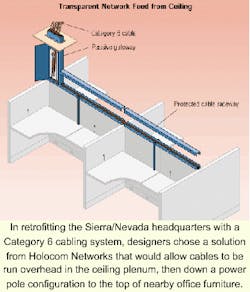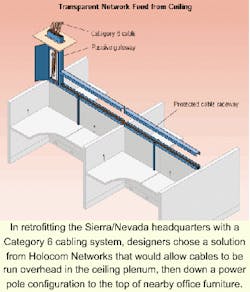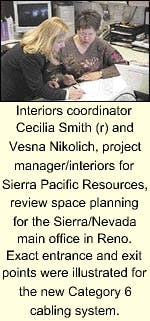Sierra Pacific, Nevada Power merger requires interdepartmental and supplier cooperation.
Kent Foster
In the world of mergers and acquisitions, the period after a deal is signed often turns into a period of headaches and nightmares for facilities and IT department staff. The 1999 merger of Sierra Pacific Power and Nevada Power Company was no exception. As happens in many mergers, voice, data networks, facilities and other operating functions needed to be incorporated into one cohesive unit. Two independent voice and data networks would not be acceptable for the combined utility company that supplies a basic necessity to nearly a million people and businesses throughout Nevada and parts of California.
Vesna Nikolich, project manager interiors for Sierra Pacific Resources-the holding company of both utilities-and IT analyst Chuck Benton of Nevada Power were assigned the respective tasks of remodeling Sierra Pacific's corporate headquarters in Reno, as well as upgrading and integrating that building's computer network. A tight budget and time frame was set for the project that included work on more than 300 workstations at three different general office buildings of the newly merged company.
The project was to be completed within the 2000 calendar year, which meant that Nikolich and Benton had to quickly join forces. Together, they created a plan that scheduled upgrading of the network at the same time that areas of the building were under remodeling construction. The remodeling team would set the pace, and the IT department would do their work to coincide, thereby causing minimum disruption to ongoing business operations.
From token ring to switched
To create a new, unified data network, a company-wide switched Ethernet based system was chosen. That meant Sierra's token ring network had to be scrapped, which involved removing interface cards from workstations as well as old network equipment and token ring routers, and installing a new switched network device from a local supplier.
In the process, Benton discovered that a cable management system didn't exist within the Reno building. In addition, Sierra was using an IBM Category 3 cabling system that combined voice and data cable in one sheaf. Cable pathways in the building were filled to capacity with Category 3 cable used for both voice and data.
A further challenge was that the new network called for Category 6 cable. If the old cabling was to be pulled out before the new cabling was installed, both the data network and voice telephone systems would have been disabled, bringing operations to a halt and violating the project's directive for a seamless integration and cut-over.
On the facilities side, significant challenges also existed. "Given the investment both companies had in furniture, the option to replace everything didn't exist," states Nikolich. "Very early in the project, it was apparent to both the facilities and IT departments that a cable management system had to be found that was invisible to the eye and flexible enough to work with the three different types of modular furniture we had in our inventory. We didn't know what that system was or who made it, but we had to find a way to utilize our available resources to achieve uniformity within the merged company."
The only alternative to installing a completely new furniture system was to have IT personnel run cables along the floor with clips and duct tape. Clearly, this was a not an acceptable solution to either department.
An over the top decision
It was decided that the best option was a cable management system that would allow cables to be run overhead in the ceiling plenum, then down a power pole configuration to the top of the various models of modular furniture: Steelcase 9000 systems, Steelcase Avenir, and freestanding desks. Facilities mandated that voice and data cabling be invisible to customers and employees, and IT wanted protected cable raceways and the capability for rapid expansion.
Since schedule deadlines were tight, both departments began their search for a product to meet their specifications. The overall integration of the project mandated by the merger involved several phases of physical remodeling and, therefore, the cut-over to the new network was divided into workstation groups of approximately 20. Cut-overs had to coincide with remodeling schedules to minimize disruption to workers and customers. Another pressing issue facing Benton's IT group was the institution of a new customer information system (CIS) that the company wanted operational within the year. This required the new network to be in place before the CIS was brought on line.
In sourcing a solution, it is not surprising that IT personnel looked to cabling and equipment providers and that facilities personnel turned to furniture suppliers. It was Nevada Power's facilities team, led by interiors coordinator Cecilia Smith, who uncovered a potential solution from Machabee Office Environments, a local Steelcase office furniture supplier in Las Vegas. Machabee suggested a set of specialized products from Holocom Networks (Carlsbad, CA; ww.holocomnetworks.com) as a solution. Holocom's solution provided a pathway for voice and data cable to run down from overhead plenum conduits, to a specialized termination and testing point incorporating a multi-user telecommunications outlet assembly (MUTOA) within the company's Passive Gateway system. From the head of each work group, cabling would run across the tops of all of the furniture to each workstation, by way of Holocom's Top Runner raceway system.
After seeing an exhibit of Passive Gateway and TopRunner at the NetWorld & Interop trade show in Las Vegas, both IT and facilities planners believed the system offered everything they needed-flexibility to retrofit on virtually any manufacturer's modular furniture, appearance and function to handle any voice/data cabling scheme, and no-risk new network installation and cut-over. Holocom's solution was also easy to move and to modify, which would be important in the case of future expansion and/or mergers.
In his role as IT analyst, however, Benton needed assurance that the system would work for his department. So he sought advice from project installer NetVersant (Houston, TX). This was very important to Benton as the installer warrantees its cabling work for 15 years, and if they were not convinced this was the solution, then the Sierra/Nevada team would have to continue their search.
No power outages allowed
Meanwhile, time was at a premium. The actual cabling had to begin within a month for the project to be completed on schedule. Downtime for a utility is unacceptable, so when Benton told NetVersant and Holocom that his lead-time was only three weeks to get the first 20 workstations up on the new network, he wanted an answer and he needed it fast.
Benton had Holocom's brochure in the hands of NetVersant's owner, Dennis Pritchard. "I was asking Pritchard to place his company's guarantee on something with which he wasn't familiar. The product looked like it could meet our needs, Holocom's guarantees were equal to NetVersant's. Together, we decided to go for a trial installation." Holocom quickly shipped a single unit for trial installation in Sierra's Reno office, which proved to be successful.
With the purchase approved, the facilities team at Sierra Pacific was able to add the Passive Gateway/TopRunner product into the layout and diagrams for the remodeling project. Interiors coordinators Cecilia Smith and Debbie Johnson had been doing the space planning for the general office building in Reno and now were able to illustrate exactly where the Holocom product entrance and exit points would be.
Transparent solution
Customers and employees of Sierra/ Nevada didn't even notice the system. According to Vesna Nikolich, a part of the team from start to finish, "I know what to look for and I know our network feed from the ceiling-the Holocom system is transparent. Our users and our customers don't even notice it. It works well with the actual interior of our office and the various models of furniture."
As for the cut-over, IT analyst Benton adds, "There were times when all we had was overnight to make the switch from the old network to the new one. We were able to achieve this with everyone's cooperation. Facilities helped by accommodating remodeling schedules. We didn't want to double the work by cabling an area twice. We accomplished our goal of a seamless integration to the new network. Outside of our office, no customer of Sierra/Nevada-internal or external-was affected."
The cabling and remodeling project at the central general office building was completed on schedule during the 2000 calendar year, with the last two phases of the Holocom-based cabling project actually installed by in-house staff.
Kent Foster is senior account executive/high tech with public relations and marketing firm Mentus Inc. (San Diego, CA).



